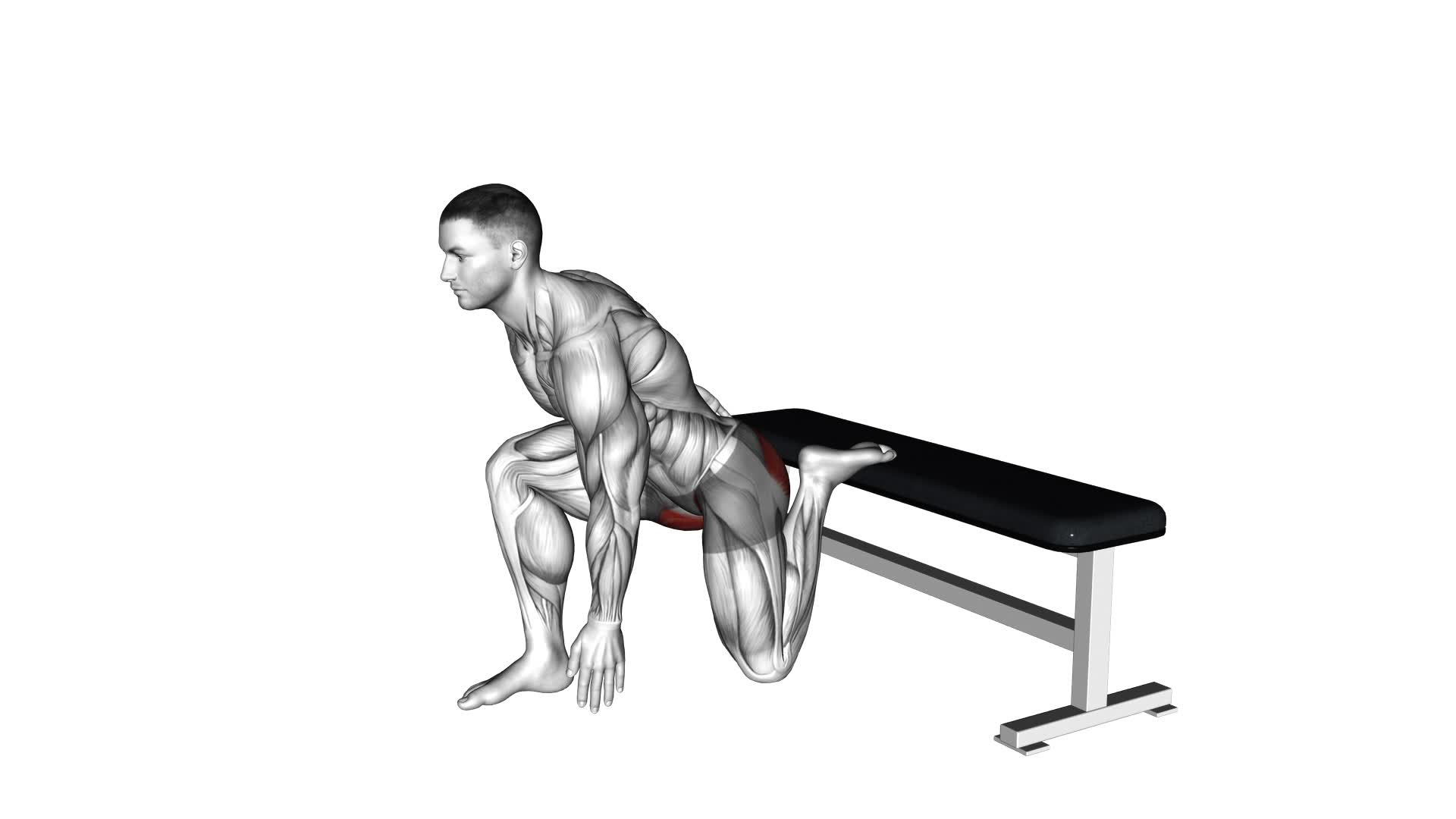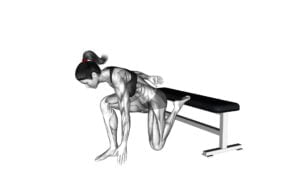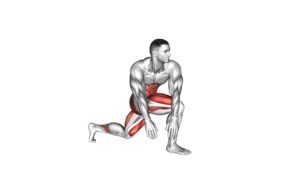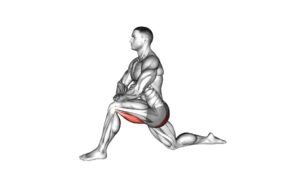Hip Flexor Stretch Rear Foot Elevated (Male) – Video Exercise Guide & Tips

In this video exercise guide, we'll show you how to perform the hip flexor stretch with your rear foot elevated.
Watch This Exercise Video
This stretch is beneficial for increasing flexibility and reducing tightness in your hip flexor muscles.
You'll learn the proper technique and common mistakes to avoid, as well as tips for maximizing the effectiveness of the stretch.
Whether you're a beginner or advanced fitness enthusiast, we'll also provide modifications to suit your fitness level.
Incorporate this stretch into your workout routine for improved hip mobility.
Key Takeaways
- Hip flexor stretch increases flexibility and reduces tightness in hip muscles.
- Regular stretching of hip flexors helps prevent injuries and improves range of motion in hip joints.
- Proper technique, such as maintaining a straight back and engaged core, is important for maximizing the effectiveness of the stretch.
- Gradually increasing the duration and frequency of the stretch can improve flexibility over time.
Benefits of the Hip Flexor Stretch
To experience the benefits of the hip flexor stretch, you can improve your flexibility and reduce tightness in your hip muscles. This stretch specifically targets the muscles that allow you to lift your knee towards your chest, known as the hip flexors.
By regularly performing the hip flexor stretch, you can increase the range of motion in your hip joints, leading to improved flexibility. This increased flexibility can have several advantages, such as enhancing athletic performance and reducing the risk of injuries.
Tight hip flexors can contribute to poor posture and imbalances in the muscles surrounding the hips, which may lead to hip pain and discomfort. By incorporating the hip flexor stretch into your routine, you can help prevent hip injuries and promote proper alignment.
Additionally, this stretch can alleviate the strain and tension that can accumulate in the hip muscles due to prolonged periods of sitting or physical inactivity.
Now, let's move on to discuss the proper technique for the rear foot elevated stretch.
Proper Technique for the Rear Foot Elevated Stretch
Now let's delve into the proper technique for performing the rear foot elevated stretch, building upon the benefits discussed in the previous subtopic. To ensure effective execution of this stretch, it's important to address common misconceptions and explore variations of the stretch.
One common misconception is that this stretch primarily targets the quadriceps. While it does involve the quadriceps to some extent, the rear foot elevated stretch primarily targets the hip flexors, specifically the iliopsoas muscle group. These muscles are responsible for flexing the hip joint, and when tight, can lead to decreased mobility and increased risk of injury.
To perform the rear foot elevated stretch, begin by assuming a lunge position with one foot forward and the other foot resting on a stable elevated surface, such as a bench or step. Keep your torso upright and engage your core for stability. Slowly lower your back knee towards the ground, feeling a stretch in the front of your hip. Hold this position for 20 to 30 seconds, then switch sides and repeat.
There are variations of the rear foot elevated stretch that can be utilized to increase or decrease intensity. For example, by leaning forward slightly, you can increase the stretch on the hip flexors. Conversely, by leaning back, you can decrease the intensity of the stretch.
Common Mistakes to Avoid During the Exercise
Avoid these 3 common mistakes when performing the rear foot elevated stretch:
- Incorrect foot placement: Placing your foot too close or too far from your body can impact the effectiveness of the stretch. To ensure proper form, position your foot directly under your hip, with your toes pointing forward.
- Arching your back: It's crucial to maintain a neutral spine throughout the exercise. Avoid arching your back excessively, as this can strain your lower back and diminish the stretch's benefits. Engage your core muscles to support your spine and keep it in a stable position.
- Lifting your front heel: During the stretch, it's important to keep your front heel grounded. Lifting your heel can shift the focus away from your hip flexors and reduce the stretch's effectiveness. Ensure that your entire foot remains in contact with the floor.
- Rushing the movement: To fully engage your hip flexors and reap the benefits of this stretch, it's essential to perform it slowly and with control. Avoid rushing through the exercise, as this can lead to compromised form and reduced effectiveness.
Proper form is crucial for the rear foot elevated stretch. By avoiding these common mistakes, you can ensure that you're targeting the hip flexors effectively and minimizing the risk of injury. Take your time, maintain a neutral spine, and focus on correct foot placement to optimize the benefits of this exercise.
Tips for Maximizing the Effectiveness of the Stretch
To maximize the effectiveness of the hip flexor stretch, it's important to focus on proper form techniques. Ensure that your back is straight, your core is engaged, and your hips are square.
Additionally, pay attention to your breathing techniques, taking deep inhales and exhales to help relax the muscles and increase the stretch.
Proper Form Techniques
For maximum effectiveness of the hip flexor stretch, position yourself with your rear foot elevated on a stable surface. This proper form technique allows you to target the hip flexor muscles more effectively, ensuring a deeper stretch and greater benefits.
To enhance your stretching experience, consider the following tips:
- Engage in deep breathing techniques: Inhale deeply through your nose, expanding your diaphragm, and exhale slowly through your mouth, releasing any tension in your body.
- Maintain proper alignment: Keep your torso upright, shoulders relaxed, and core engaged throughout the stretch.
- Make modifications for beginners: If you're new to this stretch, start with a lower elevation for your rear foot or use a support (such as a chair or wall) for balance and stability.
- Listen to your body: Pay attention to any discomfort or pain, and adjust the stretch accordingly. Remember to start slowly and gradually increase the intensity.
Breathing Techniques
Use deep breathing techniques to enhance the effectiveness of the hip flexor stretch. Proper breathing during stretching routines can help you relax your muscles and increase the range of motion.
When performing the hip flexor stretch, inhale deeply as you lower your body into the stretch, feeling the stretch in the front of your hip and thigh. Exhale slowly as you hold the stretch, allowing your muscles to release tension. Deep breathing promotes oxygen flow to the muscles, improving their flexibility and reducing the risk of injury.
By incorporating proper breathing techniques into your stretching routine, you can maximize the benefits of the hip flexor stretch.
Now, let's move on to the next section about the ideal duration and frequency for performing this stretch.
Duration and Frequency
To maximize the effectiveness of the hip flexor stretch, perform this exercise for a recommended duration of 30 seconds to 1 minute and repeat it 2 to 3 times per day. Consistency is key when it comes to stretching, so try to incorporate this stretch into your daily routine.
Here are some tips to help you make the most out of your workout duration and stretching frequency:
- Gradually increase the duration of the stretch over time to challenge your muscles and improve flexibility.
- Find a comfortable frequency that works for you, whether it's stretching every day or every other day.
- Listen to your body and adjust the frequency of the stretch based on how your muscles feel. If you're experiencing soreness or fatigue, take a rest day.
- Consider incorporating other stretches and exercises that target the hip flexors to further enhance their flexibility and strength.
Modifications for Different Fitness Levels
Increase the difficulty of the hip flexor stretch by elevating your rear foot on a step or bench. This modification, known as the rear foot elevated hip flexor stretch, adds an extra challenge to the exercise and targets your hip flexors even more effectively.
To perform this advanced variation, start by assuming the same starting position as the regular hip flexor stretch. Then, place your rear foot on a step or bench behind you, ensuring that your knee is in line with your hip. From there, proceed with the stretch as usual, focusing on maintaining proper form and feeling a deep stretch in your hip flexors.
The rear foot elevated hip flexor stretch is an excellent option for individuals who want to progress their hip flexor flexibility and challenge their muscles further. By elevating your rear foot, you increase the range of motion and intensity of the stretch, forcing your hip flexors to work harder.
However, it's important to note that this modification may not be suitable for everyone, especially those with existing knee or hip issues. If you experience any discomfort or pain while performing this exercise, it's advised to consult with a qualified fitness professional or healthcare provider.
Now that you're familiar with the stretch modifications and advanced variations, it's time to incorporate the hip flexor stretch into your workout routine.
Incorporating the Hip Flexor Stretch Into Your Workout Routine
Once you have mastered the modifications and advanced variations of the hip flexor stretch, it's time to incorporate this exercise into your workout routine. Maximizing hip flexibility is crucial for overall mobility and preventing injuries.
Here are some tips to help you seamlessly integrate the hip flexor stretch into your workouts:
- Prioritize frequency: Aim to perform the hip flexor stretch at least three times a week to maintain and improve flexibility.
- Warm up beforehand: Engage in a brief warm-up routine to increase blood flow to the muscles and prepare them for stretching.
- Include it in your dynamic warm-up: Incorporate the hip flexor stretch into your dynamic warm-up routine to activate the muscles and increase range of motion.
- Pair it with other exercises: Combine the hip flexor stretch with exercises that target the glutes, hamstrings, and core to create a comprehensive lower body workout.
Frequently Asked Questions
How Long Should I Hold the Hip Flexor Stretch For?
To get the most out of the hip flexor stretch, it's important to know how long to hold it for. Holding the stretch for about 20 to 30 seconds is a good starting point. This gives your muscles enough time to lengthen and relax.
However, if you're a beginner or feel any discomfort, you can modify the stretch by reducing the duration or decreasing the intensity. Remember to listen to your body and avoid any actions that may cause injury.
Can I Perform the Rear Foot Elevated Stretch Without a Bench or Elevated Surface?
Yes, you can perform the rear foot elevated stretch without a bench or elevated surface. There are alternative stretches and modifications you can try.
One option is to perform the stretch by kneeling on the ground with one knee bent at a 90-degree angle. Then, shift your weight forward, keeping your back straight, until you feel a stretch in the hip flexor of the opposite leg.
Remember to hold the stretch for the recommended duration for optimal results.
Is It Normal to Feel Discomfort or Tightness in the Hip Flexors During the Stretch?
Feeling discomfort or tightness in your hip flexors during the stretch is normal. This is because the hip flexors are being stretched, which can cause some discomfort.
However, if the pain is intense or persists after the stretch, it's important to consult with a healthcare professional.
To prevent hip flexor tightness, it's recommended to regularly perform hip flexor stretches and incorporate exercises that strengthen the hip flexor muscles into your routine.
How Often Should I Incorporate the Hip Flexor Stretch Into My Workout Routine?
To incorporate the hip flexor stretch into your workout routine, it's recommended to perform it at least 2-3 times per week. This will help improve flexibility and prevent tightness in the hip flexors.
You can include the stretch before or after other exercises, such as squats or lunges, to enhance their effectiveness.
Are There Any Alternative Exercises That Target the Hip Flexors?
If you're looking for alternative exercises that target the hip flexors, there are a few options you can try.
One effective exercise is the kneeling hip flexor stretch, which involves kneeling on one knee and leaning forward to stretch the front of your hip.
Another option is the standing hip flexor stretch, where you step forward into a lunge position and press your hips forward.
These exercises can provide similar benefits to the hip flexor stretch, helping to improve flexibility and reduce tightness in the hip area.
Conclusion
Incorporating the hip flexor stretch into your workout routine can provide numerous benefits, including improved flexibility, reduced muscle tension, and enhanced overall performance.
By following proper technique and avoiding common mistakes, you can maximize the effectiveness of this exercise.
Additionally, modifications for different fitness levels allow individuals to tailor the stretch to their specific needs.
Including the hip flexor stretch in your routine can help you achieve optimal results and maintain a healthy, balanced body.

Author
Years ago, the spark of my life’s passion ignited in my mind the moment I stepped into the local gym for the first time. The inaugural bead of perspiration, the initial endeavor, the very first surge of endorphins, and a sense of pride that washed over me post-workout marked the beginning of my deep-seated interest in strength sports, fitness, and sports nutrition. This very curiosity blossomed rapidly into a profound fascination, propelling me to earn a Master’s degree in Physical Education from the Academy of Physical Education in Krakow, followed by a Sports Manager diploma from the Jagiellonian University. My journey of growth led me to gain more specialized qualifications, such as being a certified personal trainer with a focus on sports dietetics, a lifeguard, and an instructor for wellness and corrective gymnastics. Theoretical knowledge paired seamlessly with practical experience, reinforcing my belief that the transformation of individuals under my guidance was also a reflection of my personal growth. This belief holds true even today. Each day, I strive to push the boundaries and explore new realms. These realms gently elevate me to greater heights. The unique combination of passion for my field and the continuous quest for growth fuels my drive to break new ground.







